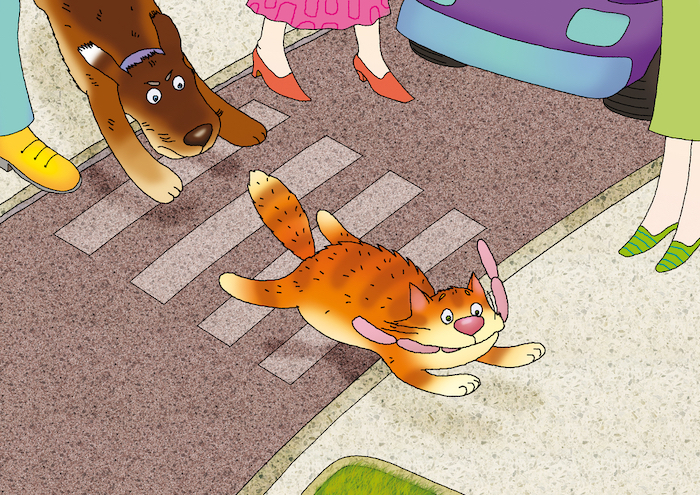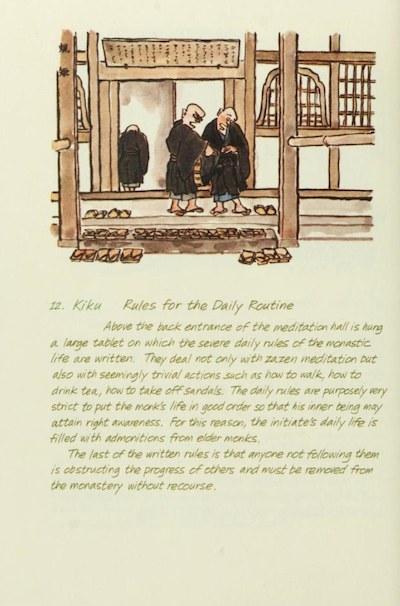Form & Nature
Forthcoming events for w/c 22nd August 2022

Dog chases cat
shutterstock
"A dog under all circumstances, good, bad and indifferent is reliably always behaving like a dog. The same is true for a cat and an oak tree. However, are we (humans) always human?"
This was a common saying from Master Daiyu and she would often use it to introduce the subject of the six realms on the Wheel of Life and talk about them as a psychological map of the human psyche.
Post-modernist critiques contain a view that there is no such thing as 'nature' and that ultimately we are blank-slates to be written on for good or for ill. However, this is a view not shared by Zen Buddhism.
Some may think that if the True Nature is 'emptiness' (sunyata), then is this not also saying we have no nature? However, 'emptiness' is not some kind of 'thing' that lies at the core of being. What it means is that all beings are composite and dependent upon external causes and conditions for existence. Once those circumstances change (as they inevitably do), then compounded beings also change. However, whilst the circumstances remain then the nature of that compounded being emerges and is in play.
Master Daiyu used to define this emergent 'nature' as the 'informing information' guiding the being in how to live its life. Thus dogs chase cats, and cats chase mice. The cherry tree blossoms in Spring and puts forth fruit in Autumn. When these three beings go out of existence the elements separate and the informing information of the elements are now in play until they re-form as other compounded beings.
However, because human beings have an afflicted consciousness that suffers from a state of delusion (attachment to a notion of a separate self), consciousness is cut off from that informing human information and thus we fall into the other non-human states we find on the Wheel of Life (fighting demons, hungry ghosts, hell beings etc.).
The Buddha said that only from the human state is liberation possible. Being in a human form (rupa), is only half the story. We must also be 'in' human consciousness'. The definition of what it is to be human in Buddhist thought is different from some common conceptions. For example, being human is about being the 'best' of what it is to be human. Quite often we think that being human is to 'sin'. We might say "Well, I'm only human." Just before behaving in a way that may not express our humanity in a way that would be considered 'best' even by my own judgement.
Thus, our conscience is seen as part of that 'informing information' of what it is to be human.
So, to be human requires effort. It also requires cultivating human skills that are dependent upon the functioning of human consciousness. The function of 'sati' translated as 'mindfulness' or 'conscious awareness' which includes not just bare attention but also discernment, is a distinct quality of human consciousness. Discernment evaluates and identifies without attaching discriminatory judgements to things. It recognises what is human from what is one of the non-human states. The moral imperative then is applied and from this the necessary behaviour change can take place.
In Zen, the use of training forms is central to this work of becoming human. Structures of behaviour are created that broadly fit the expressions of human nature as understood by long tradition that has been tried and tested over many generations. Thus we have our five lay-precepts:
Not to kill
Not to steal
Not to indulge in harmful sexual relations
Not to indulge in wrong speech
To refrain from intoxication
For monks and nuns there are further precepts and the Buddha formulated a list of such rules called vinaya which was developed over time. What is interesting is that each rule has a story of how it came about, attached to it. Thus they were created from real life, not based on some pre-packaged abstractions. Buddhism is more organic than that.
So, what happens when we break a precept? In Buddhist parlance this happens because consciousness has fallen from the human state into one of the other non-human states. And this is how we know. Just this allows us to be aware and to discern what is now happening in our Heart or Mind. At this point we practice restraint. This restraining activity and subsequent return to the practice form is the subtle alchemy that brings about the transformation of the heart energies, that leads to more instances of the arising of human consciousness and less of the other five non-human states on the Wheel.
The Buddha referred to this practice as the Four Great Efforts:
To restrain unwholesome actions
To prevent the seeds of future unwholesome actions from being planted
To give rise to wholesome actions
To plant the seeds of future wholesome actions.
When we visit a temple there is a set form that visitors are expected to adopt. How we enter the Zendo for example, how we move, hold the body and the hands. When to bow and to what and in which order. When we can talk and when we are to be silent. The emphasis is on the visitor to watch and adopt the form, preferably, without being told. As Master Daiyu says in her book The Zen Way the novices are judged on their ability and speed to adopt the forms of the temple and monastery.
The Form of Bowing
If we observe closely, we can see that these forms are not arbitrary. They all have some things in common. They are sincere, they are dignified, they support the community and the interactions between the residents. And, when one of the non-human states arises in an individual they stand out like a sore thumb!

Look carefully at the sandals to see why the monk looks cross.
Internet Archive
Following on from the Zazen Tutorial we will be running another tutorial: Developing Form in Daily Life Practice on Monday 5th September 2022 at 1900hrs BST. The Zoom invite will be posted up nearer the time. Hope to see you there!
...
Forthcoming Events for w/c 22nd August 2022
Our regular Live-streamed Zazen is on this Thursday 25th August 2022 at 1900hrs BST
Have a good week!
And good practice!
